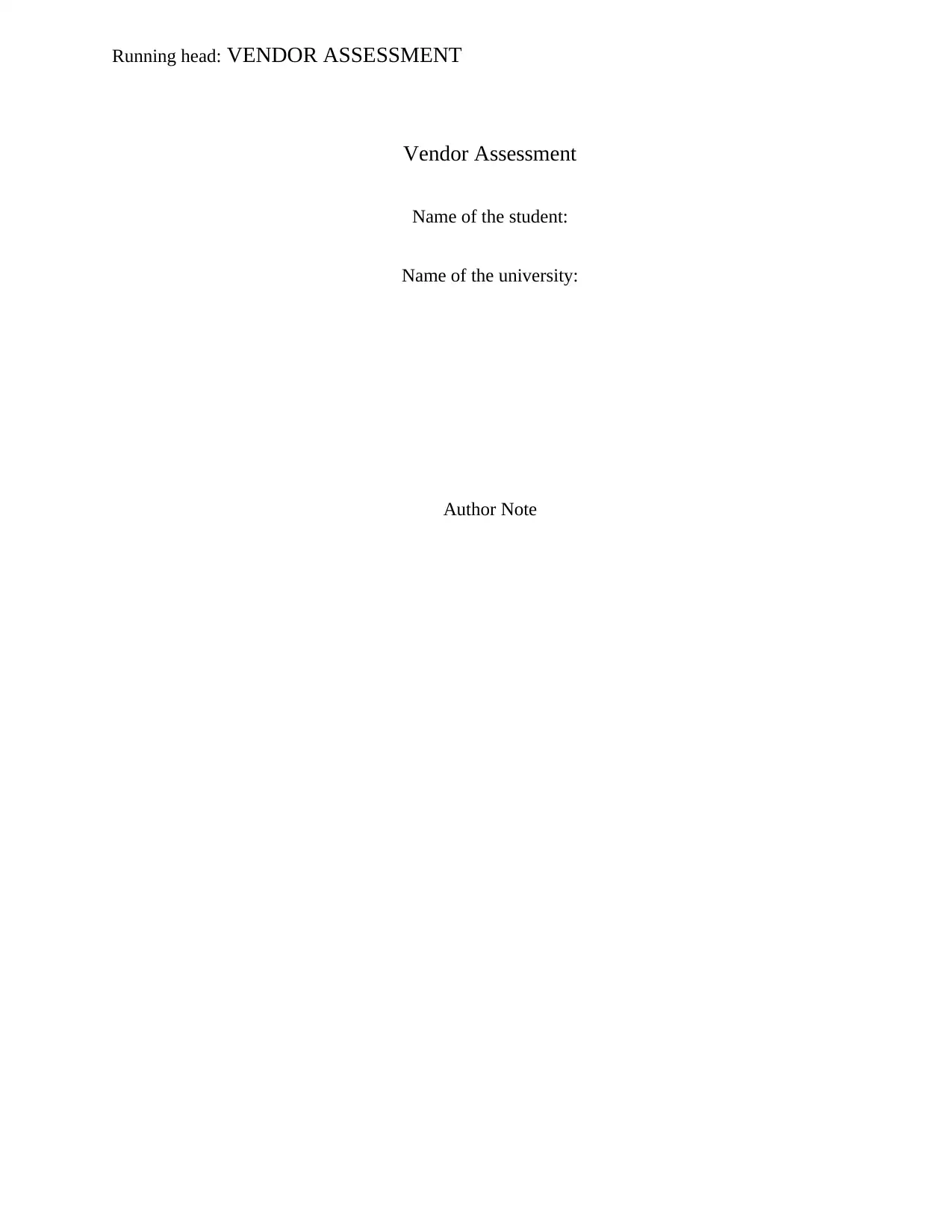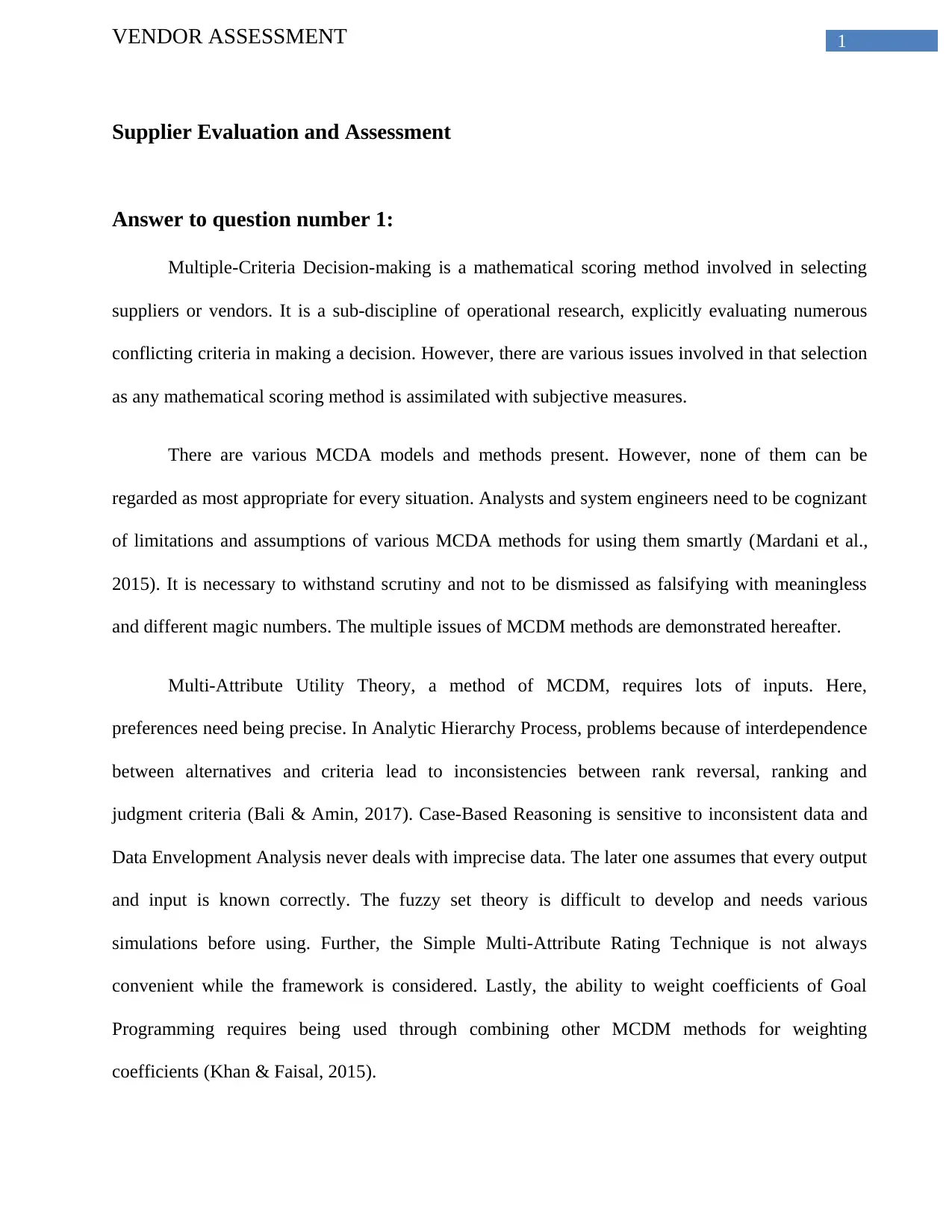Comprehensive Vendor Assessment: Selection and IT Adoption Report
VerifiedAdded on 2023/06/15
|6
|998
|150
Report
AI Summary
This report provides a comprehensive vendor assessment, focusing on supplier evaluation and selection processes. It discusses the application of multi-criteria decision-making (MCDM) methods, highlighting the issues and limitations associated with various models like Multi-Attribute Utility Theory and Analytic Hierarchy Process. The report also explores the importance of trust and trustworthiness in IT adoption and vendor selection, emphasizing the need for clear communication, thorough research, and alignment with business goals. It further investigates vendor reputation, software functionality, and customer support to ensure effective vendor partnerships. Desklib provides access to this and many other solved assignments for students.

Running head: VENDOR ASSESSMENT
Vendor Assessment
Name of the student:
Name of the university:
Author Note
Vendor Assessment
Name of the student:
Name of the university:
Author Note
Paraphrase This Document
Need a fresh take? Get an instant paraphrase of this document with our AI Paraphraser

1VENDOR ASSESSMENT
Supplier Evaluation and Assessment
Answer to question number 1:
Multiple-Criteria Decision-making is a mathematical scoring method involved in selecting
suppliers or vendors. It is a sub-discipline of operational research, explicitly evaluating numerous
conflicting criteria in making a decision. However, there are various issues involved in that selection
as any mathematical scoring method is assimilated with subjective measures.
There are various MCDA models and methods present. However, none of them can be
regarded as most appropriate for every situation. Analysts and system engineers need to be cognizant
of limitations and assumptions of various MCDA methods for using them smartly (Mardani et al.,
2015). It is necessary to withstand scrutiny and not to be dismissed as falsifying with meaningless
and different magic numbers. The multiple issues of MCDM methods are demonstrated hereafter.
Multi-Attribute Utility Theory, a method of MCDM, requires lots of inputs. Here,
preferences need being precise. In Analytic Hierarchy Process, problems because of interdependence
between alternatives and criteria lead to inconsistencies between rank reversal, ranking and
judgment criteria (Bali & Amin, 2017). Case-Based Reasoning is sensitive to inconsistent data and
Data Envelopment Analysis never deals with imprecise data. The later one assumes that every output
and input is known correctly. The fuzzy set theory is difficult to develop and needs various
simulations before using. Further, the Simple Multi-Attribute Rating Technique is not always
convenient while the framework is considered. Lastly, the ability to weight coefficients of Goal
Programming requires being used through combining other MCDM methods for weighting
coefficients (Khan & Faisal, 2015).
Supplier Evaluation and Assessment
Answer to question number 1:
Multiple-Criteria Decision-making is a mathematical scoring method involved in selecting
suppliers or vendors. It is a sub-discipline of operational research, explicitly evaluating numerous
conflicting criteria in making a decision. However, there are various issues involved in that selection
as any mathematical scoring method is assimilated with subjective measures.
There are various MCDA models and methods present. However, none of them can be
regarded as most appropriate for every situation. Analysts and system engineers need to be cognizant
of limitations and assumptions of various MCDA methods for using them smartly (Mardani et al.,
2015). It is necessary to withstand scrutiny and not to be dismissed as falsifying with meaningless
and different magic numbers. The multiple issues of MCDM methods are demonstrated hereafter.
Multi-Attribute Utility Theory, a method of MCDM, requires lots of inputs. Here,
preferences need being precise. In Analytic Hierarchy Process, problems because of interdependence
between alternatives and criteria lead to inconsistencies between rank reversal, ranking and
judgment criteria (Bali & Amin, 2017). Case-Based Reasoning is sensitive to inconsistent data and
Data Envelopment Analysis never deals with imprecise data. The later one assumes that every output
and input is known correctly. The fuzzy set theory is difficult to develop and needs various
simulations before using. Further, the Simple Multi-Attribute Rating Technique is not always
convenient while the framework is considered. Lastly, the ability to weight coefficients of Goal
Programming requires being used through combining other MCDM methods for weighting
coefficients (Khan & Faisal, 2015).

2VENDOR ASSESSMENT
⊘ This is a preview!⊘
Do you want full access?
Subscribe today to unlock all pages.

Trusted by 1+ million students worldwide

3VENDOR ASSESSMENT
References:
Bali, S., & Amin, S. S. (2017). An analytical framework for supplier evaluation and selection: a
multi-criteria decision making approach. International Journal of Advanced Operations
Management, 9(1), 57-72.
Gupta, S., Fügenschuh, A. &Ali, I., 2017. The multi-objective vendor selection problem using fuzzy
weights. Helmut-Schmidt-Universität.
Khan, H. & Faisal, M.N., 2015. A Grey-based approach for ERP vendor selection in small and
medium enterprises in Qatar. International Journal of Business Information Systems, 19(4),
pp.465-487.
Mardani, A., Jusoh, A., MD Nor, K., Khalifah, Z., Zakwan, N., & Valipour, A. (2015). Multiple
criteria decision-making techniques and their applications–a review of the literature from
2000 to 2014. Economic Research-Ekonomska Istraživanja, 28(1), 516-571.
References:
Bali, S., & Amin, S. S. (2017). An analytical framework for supplier evaluation and selection: a
multi-criteria decision making approach. International Journal of Advanced Operations
Management, 9(1), 57-72.
Gupta, S., Fügenschuh, A. &Ali, I., 2017. The multi-objective vendor selection problem using fuzzy
weights. Helmut-Schmidt-Universität.
Khan, H. & Faisal, M.N., 2015. A Grey-based approach for ERP vendor selection in small and
medium enterprises in Qatar. International Journal of Business Information Systems, 19(4),
pp.465-487.
Mardani, A., Jusoh, A., MD Nor, K., Khalifah, Z., Zakwan, N., & Valipour, A. (2015). Multiple
criteria decision-making techniques and their applications–a review of the literature from
2000 to 2014. Economic Research-Ekonomska Istraživanja, 28(1), 516-571.
Paraphrase This Document
Need a fresh take? Get an instant paraphrase of this document with our AI Paraphraser

4VENDOR ASSESSMENT
Answer to question number 2:
Applied to the management of IT adoption and analysis, it is seen that trust and
trustworthiness, combined statistically have a direct impact on IT assessment and approval. As in
any case, the trusted party leaves the scenario the risk of dependence and future actions on those
actions turns out to be irrelevant to those trusted party (Hallikainen & Laukkanen, 2016).
This must be involved in vendor selection process to understand what is to be accomplished.
It helps in being specific to define and document departmental necessities and project goals. Further,
it is also helpful in developing effective internal relationships. A strong partnership with, senior
executive team, finance and IT creates alignment and create a foundation for contracts. Offerings
and reputations of potential vendors are to be researched through connecting with co-workers in a
professional network (Liu, Chan & Ran, 2016). The business must be clear and open to every
possible vendor regarding what they want their technology for meeting goals. Further, vendors must
be seeking who take time to absorb and listen to requirements. Then the vendors must be used to
demonstrate how their needs are met explicitly.
All these are needed to be done to determine functionality matches. It decided whether
products have been doing what the vendors have been demanding. It is also helpful to investigate
vendor’s reputation along with assessing software functionality (Gefen & Reychav, 2014).
Moreover, it is also useful in inquiring customer support since at any time best technologies also
face occasional glitch.
Answer to question number 2:
Applied to the management of IT adoption and analysis, it is seen that trust and
trustworthiness, combined statistically have a direct impact on IT assessment and approval. As in
any case, the trusted party leaves the scenario the risk of dependence and future actions on those
actions turns out to be irrelevant to those trusted party (Hallikainen & Laukkanen, 2016).
This must be involved in vendor selection process to understand what is to be accomplished.
It helps in being specific to define and document departmental necessities and project goals. Further,
it is also helpful in developing effective internal relationships. A strong partnership with, senior
executive team, finance and IT creates alignment and create a foundation for contracts. Offerings
and reputations of potential vendors are to be researched through connecting with co-workers in a
professional network (Liu, Chan & Ran, 2016). The business must be clear and open to every
possible vendor regarding what they want their technology for meeting goals. Further, vendors must
be seeking who take time to absorb and listen to requirements. Then the vendors must be used to
demonstrate how their needs are met explicitly.
All these are needed to be done to determine functionality matches. It decided whether
products have been doing what the vendors have been demanding. It is also helpful to investigate
vendor’s reputation along with assessing software functionality (Gefen & Reychav, 2014).
Moreover, it is also useful in inquiring customer support since at any time best technologies also
face occasional glitch.

5VENDOR ASSESSMENT
References:
Dutta, D.K., Gwebu, K.L. & Wang, J., 2017. Strategy and vendor selection in IT outsourcing: is
there a method in the madness?. In Global Sourcing Of Services: Strategies, Issues And
Challenges (pp. 451-477).
Gefen, D., & Reychav, I. (2014). Why trustworthiness in an IT vendor is important even after the
vendor left: IT is accepting the message and not just the messenger that is
important. Omega, 44, 111-125.
Hallikainen, H., & Laukkanen, T. (2016, January). Consumer Trust towards an Online Vendor in
High-vs. Low-Context Cultures. In System Sciences (HICSS), 2016 49th Hawaii
International Conference on (pp. 3536-3545). IEEE.
Liu, S., Chan, F.T. & Ran, W., 2016. Decision making for the selection of cloud vendor: An
improved approach under group decision-making with integrated weights and
objective/subjective attributes. Expert Systems with Applications, 55, pp.37-47.
Sahling, F. &Kayser, A., 2016. Strategic supply network planning with vendor selection under
consideration of risk and demand uncertainty. Omega, 59, pp.201-214.
References:
Dutta, D.K., Gwebu, K.L. & Wang, J., 2017. Strategy and vendor selection in IT outsourcing: is
there a method in the madness?. In Global Sourcing Of Services: Strategies, Issues And
Challenges (pp. 451-477).
Gefen, D., & Reychav, I. (2014). Why trustworthiness in an IT vendor is important even after the
vendor left: IT is accepting the message and not just the messenger that is
important. Omega, 44, 111-125.
Hallikainen, H., & Laukkanen, T. (2016, January). Consumer Trust towards an Online Vendor in
High-vs. Low-Context Cultures. In System Sciences (HICSS), 2016 49th Hawaii
International Conference on (pp. 3536-3545). IEEE.
Liu, S., Chan, F.T. & Ran, W., 2016. Decision making for the selection of cloud vendor: An
improved approach under group decision-making with integrated weights and
objective/subjective attributes. Expert Systems with Applications, 55, pp.37-47.
Sahling, F. &Kayser, A., 2016. Strategic supply network planning with vendor selection under
consideration of risk and demand uncertainty. Omega, 59, pp.201-214.
⊘ This is a preview!⊘
Do you want full access?
Subscribe today to unlock all pages.

Trusted by 1+ million students worldwide
1 out of 6
Your All-in-One AI-Powered Toolkit for Academic Success.
+13062052269
info@desklib.com
Available 24*7 on WhatsApp / Email
![[object Object]](/_next/static/media/star-bottom.7253800d.svg)
Unlock your academic potential
Copyright © 2020–2025 A2Z Services. All Rights Reserved. Developed and managed by ZUCOL.